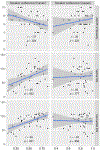Puppets facilitate attention to social cues in children with ASD
- PMID: 34350712
- PMCID: PMC8434944
- DOI: 10.1002/aur.2552
Puppets facilitate attention to social cues in children with ASD
Abstract
Diminished visual attention to faces of social partners represents one of the early characteristics of autism spectrum disorder (ASD). Here we examine if the introduction of puppets as social partners alters attention to speakers' faces in young children with ASD and typically developing (TD) controls. Children with ASD (N = 37; Mage = 49.44 months) and TD (N = 27; Mage = 40.66 months) viewed a video depicting a puppet and a human engaged in a conversation. Dwell time on these faces was analyzed as a function of group and speaker's identity. Unlike TD controls, the ASD group exhibited limited visual attention to and chance-level visual preference for the human speaker. However, attention to and preference for the puppet speaker's face was greater than chance and comparable across the two groups. While there was a strong association between low human speaker preference and high autism severity, no association with autism severity was found for puppet speaker preference. Unlike humans, expressive and verbal puppets attracted the attention of children with ASD at levels comparable to that of TD controls. Considering that puppets can engage in reciprocal interactions and deliver simplified, salient social-communicative cues, they may facilitate therapeutic efforts in children with ASD. LAY SUMMARY: While studies have shown support for therapeutic uses of robots with children with autism, other similar agents such as puppets remain to be explored. When shown a video of a conversation between a puppet and a person, young children with ASD paid as much attention to the puppet's face as typically-developing (TD) children. Since puppets can engage in back-and-forth interactions and model social interactions and communication, they may play a promising role in therapeutic efforts for young children with ASD.
Keywords: attention; eye tracking; puppets.
© 2021 International Society for Autism Research and Wiley Periodicals LLC.
Conflict of interest statement
CONFLICT OF INTEREST
The authors report no conflict of interest.
Figures




References
-
- American Psychiatric Association. (2013). Diagnostic and statistical manual of mental disorders: DSM-5. American Psychiatric Pub.
-
- Ashby FG, & Isen AM (1999). A neuropsychological theory of positive affect and its influence on cognition. Psychological Review, 106(3), 529–550. - PubMed

